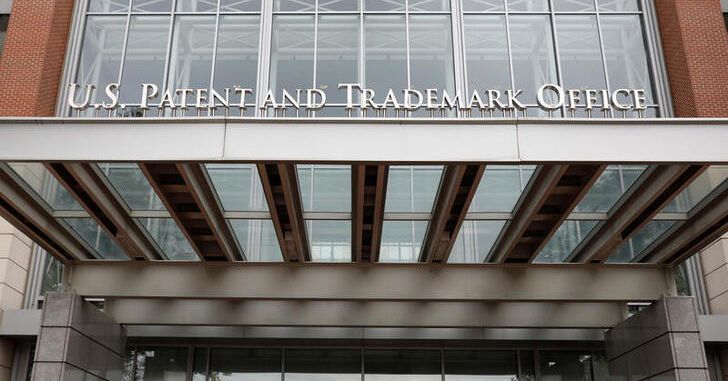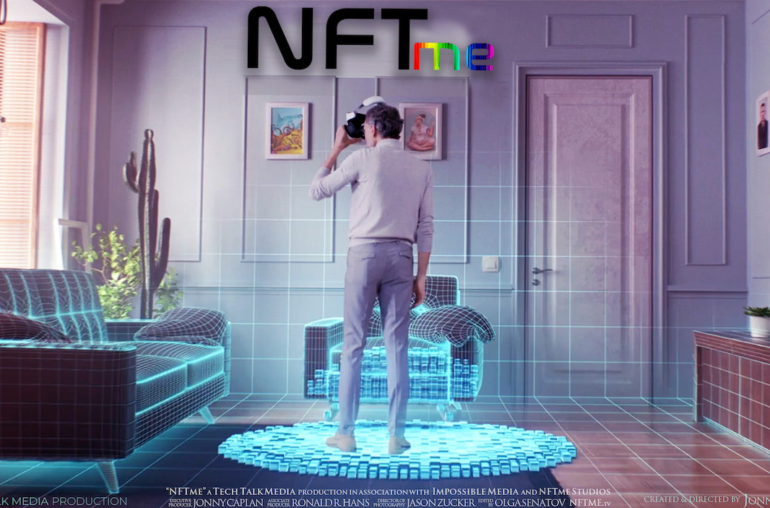The United States Patent and Trademark Office (USPTO) is seen in Alexandria, Virginia, U.S. REUTERS/Andrew Kelly
June 17, 2022 – Although NFT technology is relatively new, the intellectual property laws governing it are not. Nevertheless, increased popularity of innovative technologies like NFTs, as brands expand their presence in the metaverse, can raise novel legal questions.
In our last article we discussed how design patents can protect NFTs. Now it's time to consider how existing trademark and copyright laws can be used to protect brands, NFTs, and NFT-related products in real life and the metaverse, a three-dimensional virtual world that often mimics the physical world we live in. People in the metaverse can gather to play games, socialize, and network virtually. Companies with wider presences in the metaverse can bolster their trademark and copyright protections in that space.
A trademark is a designation used to identify and distinguish the source of goods and services of a person or company from other sources. Typically, trademarks consist of one or more letters (e.g., Chanel's interlocking Cs), a word (e.g., Starbucks), an image (e.g., Apple's bitten apple), shape (e.g., Nike's swoosh), or colors (e.g., Christian Louboutin's red soles). Trade dress, a subset of trademark law, protects the visual appearance of a product or its packaging (e.g., the shape of a Hershey Kiss).
There is nothing inherently unique about applying for trademark registrations covering NFTs. The mark must be used in commerce, distinctive, and used as a source identifier for specific goods and services.
The critical issue is registering the mark in the correct class. The United States Patent and Trademark Office (USPTO), which oversees the registration of federal trademarks, divides trademarks into 45 classes of goods and services.
Individuals and entities minting NFTs should consider filing in classes 9 (computers and scientific devices), 35 (advertising and business services), 41 (education and entertainment services) and 42 (science and technology services). Many brands across industries have applied for NFT trademark registrations, including Johnson & Johnson, 3M, L'Oréal, Coach, Gucci, Balenciaga, Wendy's, Utz, Mastercard, Mattel, and Lion's Gate.
A federal trademark registration provides two main benefits: (1) protection, and (2) engagement.
First, a federal trademark registration provides the brand exclusivity because only the trademark owner can legally use the trademark as a name/mark for its NFTs. Trademark ownership also is critical to combating counterfeiters. Just like in the physical world, trademark registrations are required to bring an NFT counterfeiting claim.
Second, trademark ownership eases development of advertising campaigns and licensing/collaboration opportunities, which are particularly important when companies enter the metaverse. For example, Balenciaga and Fortnite (owned by Epic Brands) have collaborated, which could expand to co-branded NFTs in the future. Indeed, Balenciaga has a dedicated business unit on metaverse issues focusing on virtual experiences and offerings.
Currently, two notable cases involving NFT and trademark rights are pending before the United States District Court for the Southern District of New York. These cases are among the first significant trademark matters involving NFTs to be litigated.
Hermès Int'l v. Rothschild. As discussed in our first article in this series ("Demystifying NFTs and intellectual property: what you need to know," Reuters Legal News and Westlaw Today, May 10, 2022) Hermès filed a lawsuit against artist Mason Rothschild after he began selling NFTs displaying the Hermès "Birkin Bag" using the designation METABIRKINS. In addition to claiming infringement and dilution of its BIRKIN mark, Hermès alleged that Rothschild infringed its trade dress for the Birkin Bag (here, the overall shape and design of the bag).
Rothschild moved to dismiss, raising a First Amendment defense. In doing so, Rothschild relied on the test from Rogers v. Grimaldi (2d Cir. 1989), which states that the use of a mark in an expressive work is protected speech and thus non-infringing (even when sold for profit) where (1) the work is artistically relevant, and (2) the use is not "explicitly misleading."
In response, Hermès amended its complaint, providing additional context for its trademark infringement claims. Rothschild moved to dismiss again, still relying on the Rogers test to support his allegation that Hermès's claims fail.
On May 18, 2022, the court issued a decision on the motion to dismiss. Although the court held that the Rogers test applies to at least the trademark infringement analysis, it refused to dismiss Hermès's claims. The court held that whether Rothschild's use of the BIRKIN mark is explicitly misleading as to the source or content of the work was a factual determination that cannot be determined at the motion to dismiss stage.
Nike, Inc. v. StockX LLC. StockX, an e-commerce resale platform, launched The Vault in late 2022, allowing buyers to track ownership of physical products (e.g., sneakers) purchased on StockX and warrant their authenticity. Nike then sued StockX, alleging that StockX's use of Nike's famous marks in connection with its NFTs constituted trademark infringement.
Nike's first complaint alleged that StockX minted NFTs using Nike's trademarks without authorization. StockX filed an answer, explaining that the NFTs are not physical products and claiming that its NFTs did not violate any of Nike's rights. StockX's answer also asserted that each NFT was tied to a specific physical good that was already authenticated by StockX.
Consequently, Nike sought leave to file an amended complaint to include counterfeiting and false advertising claims. Specifically, Nike asserted that it made test purchases from StockX and determined that at least four pairs of shoes that StockX claimed were authentic were in fact counterfeit.
On May 24, 2022, StockX filed a notice informing the court that it did not intend to oppose Nike's motion, which remains pending.
Copyright protects original works of authorship fixed in a tangible form of expression, giving the owner the right to copy and distribute the fixed work for a period of time. Types of works that can be protected by copyright include paintings, photographs, illustrations, musical compositions, sound recordings, computer programs, books, poems, blog posts, movies, architectural works, and plays.
To receive registered copyright protection, a work must be "original," meaning that the author created it independently. It also must possess at least some minimal degree of creativity to receive copyright registration. Many NFTs qualify for copyright protection.
Things become murkier when someone sells an NFT, often in the metaverse. Purchasing an NFT can be analogized with purchasing a painting. Typically, the buyer obtains the rights to resell and display the painting but does not own the painting's underlying copyright.
What the NFT purchaser ultimately obtains, which may or may not include a copyright, will be outlined in the smart contract associated with the NFT and depend on the seller, platform, and listing. Because NFTs are fairly new, this has caused some market confusion.
Recent transactions reflect that confusion. For example, OpenSea withdrew a Basquiat drawing NFT from an auction after the artist's estate objected to the seller's claim that the sale of the NFT would include the rights to the physical artwork, including the right to destroy the work.
As another example, a group called Spice DAO spent $3 million on a rare copy of the book Dune by film-maker Alejandro Jodorowsky, originally stating that it intended to splice and sell NFTs based on the book. Yet, Spice DAO did not purchase the copyright to Dune and therefore likely could not convert it without facing a lawsuit from the copyright holder.
In addition to obtaining registrations for trademarks and copyrights, which will provide necessary tools to prevent others from misusing valuable brand assets, brands also may consider establishing a presence in the metaverse by offering their products and goods, setting up virtual showrooms, and taking other steps to expand their footprint and establish use of their brands. Doing so not only offers companies expansion opportunities but may assist in preventing widespread unauthorized use of intellectual property rights by third parties and make it easier to enforce registered rights.
Brands also should monitor the metaverse for unauthorized uses of their trademarks, trade dress, and copyrights. Ideally, enforcement actions should be taken as soon as an infringing NFT is listed for sale on an exchange, preferably before it is sold.
Mary Kate Brennan is an associate at Finnegan, Henderson, Farabow, Garrett & Dunner, LLP, and is located in the Washington, D.C., office. She focuses her practice on trademark, false advertising, and copyright litigation for a variety of domestic and international clients. She can be reached at [email protected].
Soniya Shah is an associate at Finnegan, Henderson, Farabow, Garrett & Dunner, LLP, and is located in the Washington, D.C., office. She focuses on patent litigation and prosecution and handles intellectual property matters related to electronics and information technology. She can be reached at [email protected].
Anna Naydonov is a partner at Finnegan, Henderson, Farabow, Garrett & Dunner, LLP, and is located in the Washington, D.C., office. She focuses her practice on trademark and false advertising litigation, routinely litigating high-stakes cases for some of the world’s most renowned brands. She can be reached at [email protected].
Thomson Reuters Institute
Gina Jurva
Megha Jain
Gregg Wirth
Reuters, the news and media division of Thomson Reuters, is the world’s largest multimedia news provider, reaching billions of people worldwide every day. Reuters provides business, financial, national and international news to professionals via desktop terminals, the world's media organizations, industry events and directly to consumers.
Build the strongest argument relying on authoritative content, attorney-editor expertise, and industry defining technology.
The most comprehensive solution to manage all your complex and ever-expanding tax and compliance needs.
The industry leader for online information for tax, accounting and finance professionals.
Access unmatched financial data, news and content in a highly-customised workflow experience on desktop, web and mobile.
Browse an unrivalled portfolio of real-time and historical market data and insights from worldwide sources and experts.
Screen for heightened risk individual and entities globally to help uncover hidden risks in business relationships and human networks.
All quotes delayed a minimum of 15 minutes. See here for a complete list of exchanges and delays.
© 2022 Reuters. All rights reserved


